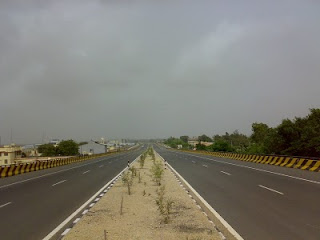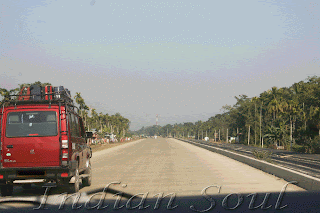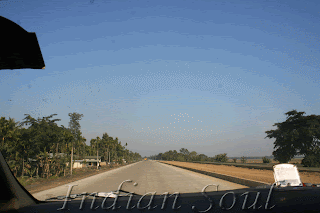By no means one can doubt the govt's intent to build highways, upgrade existing ones and new expressways since 1998. Right from 1998 till now, the thrust has only been increasing. Increased private sector participation has created a momentum like never before. Yet there are some serious shortcomings on why we cannot aggressively pursue and proceed like what China is doing. Let's not forget, China too faces the same problem. However, why compare with China? Simply because China and India have some of the same problems w.r.t population density. The fact remains being a communist country, the state can virtually control everything.
CHALLENGES or PROBLEMS and RELEVANT SOLUTIONS: (the order is the most complex first, the last is the least complex one)
1) Chinese problem was that of LAND ACQUISITION which India faces today. As China proceeded in the 1990's, it faced the legal problem of how to take land from farmers for construction of roads. This research paper gives some insightful details of how China aggressively took farmers lands for construction of highways and how several farmers have not been getting adequate compensation and participation in the post-completion of highways. In 1998, China passed compulsory Land Acquisition Act. Some of its features:
BENEFITS FARMERS ARE GOING TO GET IN LIEU OF GIVING UP LAND |
Raised compensation level to 6-10 times the annual output value of the acquired land in the preceding 3 years. |
Farmers and their kids would get access to public schools and access to public goods at subsidized prices. |
Other social welfare schemes such as medical insurance, pension and retirement benefits |
THE PROBLEMS FACED BY THE FARMERS WHO HAVE GIVEN UP LAND |
Farmers don’t get adequate compensation as compensation guidelines are ambiguous. |
What constitutes a public purpose is also undefined. Some industrialists acquire land in the name of public interest which is a violation of the law. |
There is no clear definition of property rights for the farmers, village organization and land tenure. |
The farmers get false promises that they would be trained in the right skills to build either the roads or new industries that may come up. But it doesn’t happen. So, in effect they lose the land, lose their income and are deprived of new skills. |
The point below violates the very law of acquisition which promises better living standards for the farmers whose land has been taken |
It is very clear that in developing economies like India and China planning and construction of roads began after several decades when people settled everywhere. People who understand the above table can easily understand what happens to farmers when their land is acquired at extremely low prices than prevailing in the existing market. So, while the question remains how we acquire land, India has drafted its own LAND ACQUISITION ACT way back in 1984. However, our ACT has some of the same loopholes as China. Unlike in China where land is acquired and there is no easy way out, in India farmers can go for a prolonged litigation and this litigation delays many projects. It is not that farmers do not want to give up land, it is the question of compensation. The market value/sale deed value is intentionally kept low to avoid stamp duty and hence the govt rules of compensation is too low for farmers to give up such huge tracts of land.
Farmers are interested to give up land, but there is no adequate compensation given and that is why they go to courts. Litigations prolong lot of cases. In some cases, the settlement is quick and final. 80% of cases in China too go to courts, but the govt has a way of quicker way of settling disputes unlike India which does not mandate quick resolution. China enacted such a law in 2010 and India should eventually do. CLICK HERE |
Rs.8000 to Rs.10,000 CRORE worth of projects get entangled in legal disputes. |
Solution: Amend the Act to use a different formula for compensation and speeden up dispute resolution.
2) Lack of Proper Funding model:
Earlier, the govt would give all the money, but as land and material prices went exponentially high, banks and other sources had to be pitched. The govt even moved to VIABILITY GAP FUNDING - wherein 40% of the money Govt would bear to pay throughout the construction period. The remaining money has to be borne by the contractors and they go in for Banks. However, banks don't trust many of the projects and builders. They consider some projects as unviable for funding.
The Govt went in and made 100% FDI in road investment to attract foreign players. Land acquisition delays continue to repel the foreign players from entry. Malaysia, UK, Canada, China and US have been asked to invest.
Solution: Govt has decided to raise money from capital gains tax exemption bonds, external commercial borrowing, infrastructure bonds, term loans and loans from agencies, banks and financial institutions
3) Lack of managerial ability - Simply speaking, this is the biggest mammoth exercise that requires great managerial skills which political system cannot consistently give.
Solution: Ensure that the right candidate can be fixed by the Govt like Mr.Shreedharan of the Delhi Metro.
On THE POSITIVE SIDE:
1) There are so many market players ready to investment. Reliance, L&T, Sadhbav Engineering, Nagarjuna, GMR, IVRCL Tatas, Birlas, Hiranandani's etc that is pitching in crores of rupees.
2) Banks have been asked to lend more money.
3) Lot of policy hurdles have been removed. They are listed below:

(views of Mumbai Pune expressway and Ahmedabad Vadodara expressway part of Golden Quadrilateral)
STATISTICS:
AS OF April 30, 2010 (http://nhai.org/) Highways that connect more than 100 important and major cities including METRO's which are 4/6 laned:
Conclusion: We have scope for almost 40-50000 km that are under various stages of bidding and implementation. Some are yet to be awarded. However, the most important achievement is that almost all major city highways are covered with 4-6 lanes.
Earlier, the govt would give all the money, but as land and material prices went exponentially high, banks and other sources had to be pitched. The govt even moved to VIABILITY GAP FUNDING - wherein 40% of the money Govt would bear to pay throughout the construction period. The remaining money has to be borne by the contractors and they go in for Banks. However, banks don't trust many of the projects and builders. They consider some projects as unviable for funding.
The Govt went in and made 100% FDI in road investment to attract foreign players. Land acquisition delays continue to repel the foreign players from entry. Malaysia, UK, Canada, China and US have been asked to invest.
Solution: Govt has decided to raise money from capital gains tax exemption bonds, external commercial borrowing, infrastructure bonds, term loans and loans from agencies, banks and financial institutions
3) Lack of managerial ability - Simply speaking, this is the biggest mammoth exercise that requires great managerial skills which political system cannot consistently give.
Solution: Ensure that the right candidate can be fixed by the Govt like Mr.Shreedharan of the Delhi Metro.
On THE POSITIVE SIDE:
1) There are so many market players ready to investment. Reliance, L&T, Sadhbav Engineering, Nagarjuna, GMR, IVRCL Tatas, Birlas, Hiranandani's etc that is pitching in crores of rupees.
2) Banks have been asked to lend more money.
3) Lot of policy hurdles have been removed. They are listed below:
Road developers can now sell their equity stake in a project after executing it and no longer have to keep collecting tolls and allow sub contractors to take over |
A conflict-of-interest clause said that there should be no more than 5% of cross-holding between rival bidders has been increased to 25% |
In order to attract smaller companies, the restriction has been put in place by which a company which doesn’t achieve financial closure in 3 projects involving more than Rs. 3000 Crore each, it can’t bid for more. |
Land Acquisition process is expedited by involving different states and almost all states have agreed to it. |

(views of Mumbai Pune expressway and Ahmedabad Vadodara expressway part of Golden Quadrilateral)
STATISTICS:
AS OF April 30, 2010 (http://nhai.org/) Highways that connect more than 100 important and major cities including METRO's which are 4/6 laned:
% completed | Achieved (km) | Target (km) | |
Golden Quadrilateral | 98.97 | 5786 | 5846 |
North South East West Corridor | 69.41% | 5067 | 7300 |
PACE OF COMPLETION PER DAY | |
SET TARGET | 20 km/day |
ACHIEVING TARGET | 12 km/day |
Conclusion: We have scope for almost 40-50000 km that are under various stages of bidding and implementation. Some are yet to be awarded. However, the most important achievement is that almost all major city highways are covered with 4-6 lanes.



























 (This is when it is abt to rain..NH3)
(This is when it is abt to rain..NH3)










































